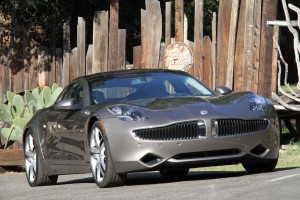Just two weeks after announcing plans to launch an all-new electric car company, Henrik Fisker is offering a hint of what’s to come with a teaser image of his first battery car.
A little Photoshop magic reveals some more of the details hidden in the shadows of the image as received from the Danish designer who first tried his hand at building cars of his own with the plug-in hybrid Fisker Karma. The most obvious detail is the use of gull-wing doors, front and back. But it’s also apparent that the coupe-like sedan offers more interior space than a conventional vehicle of its size.
Set to target the likes of the now-familiar Tesla Model S, the as yet-unnamed new model will use a breakthrough power source, a graphene supercapacitor, rather than a lithium-ion battery, to yield at least 400 miles of range.
While the new Fisker vehicle will target the high end of the automotive market, this model coming in somewhere over $100,000, the goal is to next bring to market something more affordable, perhaps even less expensive than the upcoming Chevrolet Bolt and Tesla Model 3 battery-electric vehicles, or BEVs. That would suggest a price of less than $30,000 after federal tax credits.
Delivering a low price tag for a stylish, roomy vehicle that delivers reasonable performance and even more range than a conventional, gas-powered car could help Fisker Inc. finally crack the code with consumers, pushing electric propulsion into the mainstream.
There are plenty of “ifs,” of course, and plenty of skeptics who recall the disastrous end of Fisker Automotive. It shut down in 2012, its assets being sold off in a 2013 bankruptcy. Henrik Fisker claims he has lined up the necessary funding to make the new company viable, and that he learned key lessons from the failure of Fisker Automotive that should help him pull off the successful launch of a new company.
(Bankrupt Fisker Automotive reborn as Karma. Click Here for more on its new Revero plug-in hybrid.)
But what appears to be the most critical step is his teaming up with a team of researchers from UCLA who have come up with what they tout as a complete breakthrough in energy storage. Using research that won Andre Geim and Konstantin Novoselov the 2010 Nobel Prize in physics, this new technology is actually a superconductor, rather than a conventional battery.
Mazda was actually the first to use a superconductor in a production vehicle. The technology can charge and release energy quickly, but conventional versions can’t store much power. The apparent breakthrough is the use of graphene. According to Jack Kavanaugh, who heads the new Fisker subsidiary, Fisker Nanotech, the superconductor they’re using not only can hold more power than lithium batteries but recharge much faster and be recharged more often, so its life is longer.
Fisker Nanotech also claims to have develop a new manufacturing method that will provide more than enough graphene, a material until now difficult to produce in large volume.
That, it appears, will not only take of the range issue, but also allow Fisker Automotive to downsize the battery. That’s a critical issue. The new Chevrolet Bolt, for example, may manage 238 miles per charge, but to do so requires 60 kilowatt-hours of batteries. That takes up every possible nook and cranny in the small vehicle and adds almost a half-ton of mass.
A smaller, lighter battery means improved vehicle dynamics and, according to Fisker, the new model shown here will pack in “a larger interior than its closest competitor.”
The low, sleek nose of the Fisker concept doesn’t need to hold all the gear normally found in a vehicle powered by an internal combustion engine, so some of that space can be taken over by the passenger compartment.
The goal is to get the new Fisker electric car into dealerships about a year from now.
(For more on the new Fisker Inc., Click Here.)
Production plans are still a bit vague, but Fisker will work with VLF Automotive, the suburban Detroit-based start-up that he joined last January. That teams him up with industrialist Gilbert Villarreal and automotive legend Bob Lutz.
Ironically, it also means his new car will come from a company that is also modifying versions of Fisker’s old car, the Karma. VLF has been taking the original plug-in hybrid and replacing its drivetrain with a Chevrolet Corvette ZR-1-derived LS-9 V-8. Renamed the VLF Destino, the company bills it as the world’s fastest four-door, capable of speeds “well in excess of 200 mph.”
We’ll have to wait to hear more about the performance of the new Fisker electric, though if it is going to truly compete with Tesla, with its Ludicrous Mode, performance will be a must.
(For more on the Destino, Click Here.)



Paul,
The term you should be using is supercapacitor, not superconductor. The graphene is a superconductor that makes the storage unit, the supercapacitor, more effective at storing electricity. Conductors conduct energy, they don’t store energy.
Also, the quote from Fisker is a gem. As you have it in your article: A smaller, lighter battery means improved vehicle dynamics and, according to Fisker, the new mode shown here will pack in “a larger interior than its closest interior.”
The new mode? You mean model?
closest interior? You mean closest competitor?
Really, when does the new proofreader start working?
Hi, Nick, total brain blip. I have been writing about superconductors for years and just rushed the edit to make a meeting. Will be corrected. Paul E.
Spell check replaced supper capacitor with supper conductor in the article.
Supercapacitors, not super conductors. Big difference!